Monotremes
Bird-mammal Hybrids?
|
Quit this form of man and take shape of bird.
—The Arabian Nights‡
|
|
I guess what I'm saying is, I believe that the platypus is a hybrid between a duck and a beaver.
—A visitor's comment
|
|
I stumbled upon your site 2 days ago by mere luck, looking once again for information about the platypus, which always intrigued me, and I never found a satisfying answer... what a shock! It was already 2am and I couldn't get much sleep after, I read your site for several hours, finishing by the shocking idea about human origins. Your work is brilliant, and explains many aspects that are left uncovered in other theories. There are hundreds of examples, some (very) old, even present-day ones, to refer to. I have much more to read, even though I am not a scientist. I like the way you're thinking outside of the box.
Best regards from France, Gilles
—A visitor's comments
|
This page explores the possibility of hybridization between mammals and birds. It pursues this topic
- by looking at evidence relating to the seeming hybridity of the monotremes,
- by providing links to separate pages documenting that various types of bird-mammal crosses have actually been reported, and
- by considering some cases where mammals are known to have engaged in sexual relations with birds.
There are two types of monotremes. One is the familiar duck-billed platypus. The other is the less familiar echidna. Monotremes are classified as mammals, though they lay eggs and have many other non-mammalian traits, but biologists consider them so aberrant that they have assigned all other mammmals to a separate category, Theria. Thus, all mammals other than monotremes are known as therians.
Monotremes: Bird-mammal hybrids?
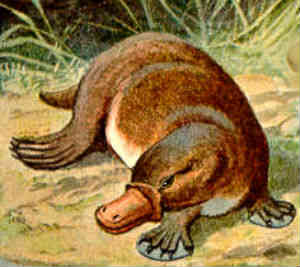 Duck-billed platypus
Duck-billed platypus
One strong clue that platypuses may be bird-mammal hybrids is the fact that in research appearing in the journal Nature Grützner et al. (2004) reported that platypuses, despite being classified as mammals, lack the gene SRY, which determines sex in mammals, and instead have a gene similar to DMRT1, which determines sex in birds (see also: Veyrunes et al. 2008). They demonstrated that the platypus genome contains sex chromosomes of both bird and mammal origin (read an article about this research >>). As Grützner, specifically stated in an interview: “The platypus actually links the bird sex chromosomes system with the mammalian sex chromosome systems.”
A draft version of the platypus genome (Warren et al. 2008) identified at least two genes otherwise known only in birds (see also Rens et al. 2007). Indeed, some of the sex chromosomes of monotremes share homology with bird sex chromosomes rather than those of mammals, report Veyrunes et al. (2008), who state that
Dohm et al. (2007) and Rens et al. (2007) have also identified regions of homology with the chicken Z sex chromosome on the platypus sex chromosomes X2p and X1p. And yet, Veyrunes et al. (2008, p. 966) found that "not a single BAC identified on the platypus sex chromosomes represented scaffolds that shared homology with the human X chromosome." In other words, researchers have found large regions of the platypus sex chromosomes that are very similar to regions on the chicken sex chromosome Z, and yet no similarity whatsoever to the sex chromosome of a mammal, i.e., the human X chromosome. And Veyrunes et al. (2008, p. 970) specifically state that "Platypus sex chromosomes are more bird-like than mammal-like."
The foregoing genetic evidence, then, is clearly consistent with the idea that platypuses are anciently derived from a cross between a mammal and a bird. So is the fact that they both lay eggs and produce milk. Their strange morphology, too, combines birdlike traits with those of a mammal. Obvious and well-known features of this sort are the presence of both a duckbill and a hair coat. But they also have a variety of lesser-known traits that seem to connect them with birds despite their classification as mammals.
If platypuses are not bird-mammal hybrids, then why should this be the case? It seems that only an extreme bias against the idea that such distant hybrids might be possible can account for the failure of scientists to recognize this obvious implication.
Available evidence for echidnas, the other type of monotreme, points in the same direction as what's available for platypuses. Like platypuses, echidnas lay eggs and produce milk. They also have a birdlike beak, but lack the feathers of a bird, and instead have a coat of spines like a hedgehog or porcupine. And they have many other avian characteristics.
The name monotreme, meaning “single orifice,” refers to the presence in both platypuses and echidnas of a cloaca, a common chamber into which the intestines, as well as the reproductive and urinary ducts, vent (Vaughan et al. 2011, p. 120). Though monotremes of both sexes do have a cloaca (as do birds, reptiles and amphibians), other mammals don't—with the exception of certain Malagasy insectivores known as tenrecs (Vaughan et al. 2011). In fact, the great French anatomist Georges Cuvier stated that the reproductive tracts of monotremes are “infinitely closer to those of oviparous animals than to those of mammals” (Recherches sur les ossemens fossile, vol. 5, p. 68).
|
|
|
Short-beaked echidna |
|
|
|
Hedgehog |
|
|
|
Kiwi |
|
|
|
Echidna spines |
|
|
|
Hedgehog spines |
It is because platypuses and echidnas have many features that are typical of birds, and not of mammals, that they are classified as separate from all other mammals. Since their genomes both contain genes otherwise found only in birds, and since they have so many other traits that connect them with birds, is it not, perhaps, reasonable to consider the possibility that they are not merely birdlike mammals, but that they are actually rare examples of hybrids descended from ancient, unusual matings between mammals and birds?
One might suppose that such distant crosses would be absolutely impossible, which is the big sticking point for some people. Indeed, there are those who are quite vehement on this point, though it's hard to see why, since little experimentation has been carried out to test the question. Commercial investigations using artificial insemination demonstrate beyond doubt that in some fairly distant crosses among birds (e.g., turkey × chicken or quail × chicken), a small percentage of fertilized eggs actually develop into mature hybrids (McCarthy 2006). And extensive experiments involving the hybridization of distantly related fish, Newman (1915, 1917 and 1918) found that many such crosses did produce hybrids, even in the case of inter-ordinal crosses.
And such findings do not go entirely against expectation. After all, it's not as if a mammal spermatozoon that suddenly found itself in the cloaca of a bird would clasp its blushing cheeks and cry, “Oh my ears and whiskers! I should not be here! Whatever shall I do?” On the contrary, one might reasonably suppose that, at least in certain instances, any such mislaid gamete might swim merrily on, and that one or more of them might at last reach an ovum, and that sometimes, perhaps very rarely, fertilization might occur. And over geological time, among the many such zygotes formed, some few might well have reached maturity and produced offspring.
Reported Crosses:
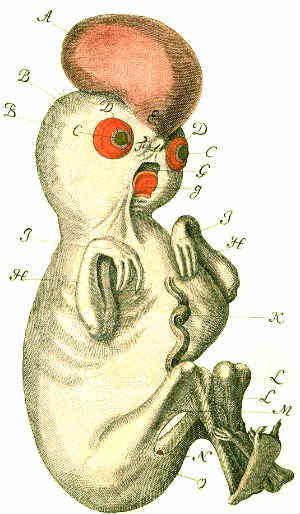 A probable human-chicken hybrid birthed by a woman in Germany in 1737. The specimen has been preserved. Details >>
A probable human-chicken hybrid birthed by a woman in Germany in 1737. The specimen has been preserved. Details >>
So it may well be that even in very distant crosses, such as one between a bird and a mammal, after many thousands of matings, a few hybrids would be produced. Indeed, by following the links in the sidebar at right, you will find that there is a great deal of evidence supporting the idea that such hybrids actually do occur. Of course, without experimentation the frequency and ease with which such hybrids are produced must remain a matter of speculation.
If platypuses and echidnas were bird-mammal hybrids it would explain why they, unlike other mammals have so many avian traits. As has already been mentioned, such traits are enumerated on a separate page of this website. As to the specific type of mammal and bird proposed as parents, for a platypus a likely choice would seem to be some sort of duck mated with an otter- or perhaps beaver-like mammal. In the case of the echidna, a reasonable combination would be a hedgehog mated with a kiwi (an echidna actually looks much like a hedgehog body with a kiwi head attached). Such crosses would, of course, be far outside what conventional biological thought would accept as possible. But, then again, perhaps convention is mistaken.
Though few biologists seem to want to come out and actually say so, these facts are consistent with the idea that birds can, at least on rare occasion, successfully hybridize with mammals. That is, judging from the morphology and genetic make-up of a platypus, it would seem that an otter-like mammal at some point crossed with a duck-like bird. For how could the platypus exist today with such a combination of chromosomes, genes and physical traits, if a bird did not at sometime in the distant past hybridize with a mammal and not only produce a hybrid, but also a hybrid that was itself capable of producing offspring?
Certainly, it is not as if such matings never occur. In fact, it has long been known that mammals and birds will voluntarily mate. Even humans sometimes mate with birds, and not just in mythology. Those who want specific documentation of this fact can consult sources ranging from Miletski (2009) to the Talmud. For example, in the latter are such passages as “Come and hear: Rab Judah said in the name of Samuel on behalf of R. Hanina: I saw a heathen buy a goose in the market, use it immorally, and then strangle it, roast, and eat it” (Abodah Zarah 22b). And Salisbury (1994, p. 73) notes that Slavic penitentials (manuals of ecclesiastical rules for imposition of penances appropriate for different sins) stipulated "a greater penalty for intercourse with a mammal than with a fowl." Presumably, no penalty would have been prescribed, if such transgressions with fowl did not occur, at least on rare occasion.
And various authors have reported coitus between birds and non-human mammals, as well. For example, on Marion Island in the southern Indian Ocean, there were two separate cases, in 2008 and 2013, of male Antarctic fur seals (Arctocephalus gazella) mating with king penguins (Aptenodytes patagonicus). In the 2008 encounter, the seal overcame the penguin by lying on top of it, while the penguin frantically flapped its flippers. The penguin, however, “showed no outward signs of injury” during or after the encounter. “The seal alternated between resting on the penguin and bouts of pelvic thrusting copulatory behaviour, attempting to penetrate the cloaca of the penguin” (de Bruyn et al. 2008). The more recent case (2013) was described in the New York Times (the BBC recently published another story on this topic, citing additional incidents). Since this behavior has been observed twice in a five-year period, one can only imagine how many times it has happened over evolutionary time.
Seals sometimes mate with birds. This video documents four different cases of Antarctic fur seals (Arctocephalus gazella) mating with king penguins (Aptenodytes patagonicus).

Dogs sometimes mate with birds.
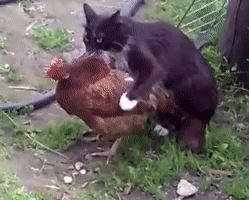
Cats sometimes mate with birds.

Rabbits sometimes mate with birds.
There are many YouTube videos showing mammals mating with birds (examples of which are shown at right), and various scholarly sources describe such behavior. For example, Paul Broca (1824-1880), the renowned French physician, anatomist, and anthropologist who also took an interest in hybridization, states the following (Broca 1859, p. 224):
Mating of rabbits (Oryctolagus cuniculus) in captivity with chickens (Gallus gallus) is discussed at length here.
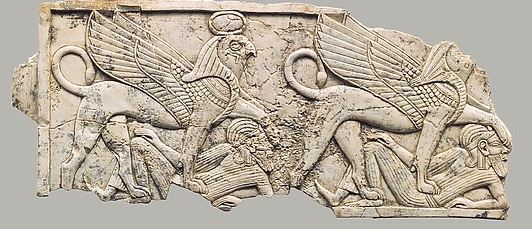 Furniture plaque carved in relief with two falcon-headed sphinxes trampling captives (Mesopotamia, Nimrud, ca. 9th-7th century B.C.).
Furniture plaque carved in relief with two falcon-headed sphinxes trampling captives (Mesopotamia, Nimrud, ca. 9th-7th century B.C.).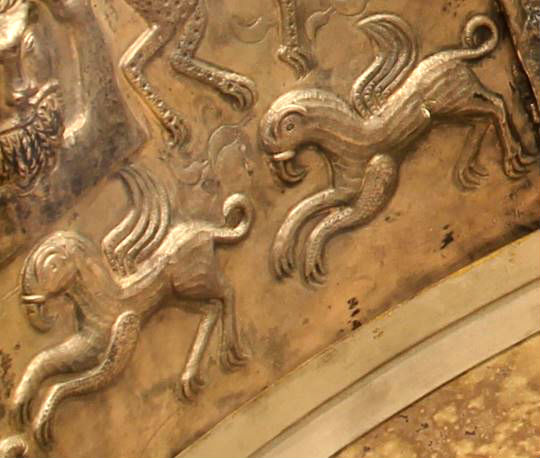 Two bird-mammal hybrids, possibly sphinxes (interior of Gundestrup cauldron, 1st or snd cen. B.C., image license: Wikimedia)
Two bird-mammal hybrids, possibly sphinxes (interior of Gundestrup cauldron, 1st or snd cen. B.C., image license: Wikimedia)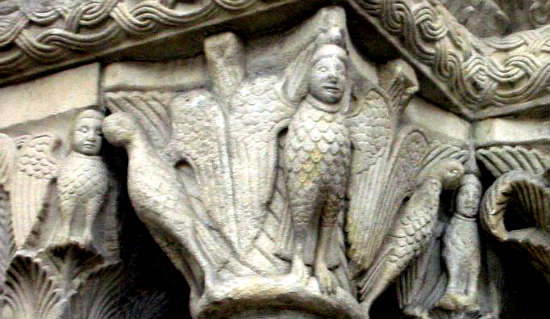 Bird-human hybrids (detail from the great south portal of the Grossmünster Church in Zurich).
Bird-human hybrids (detail from the great south portal of the Grossmünster Church in Zurich).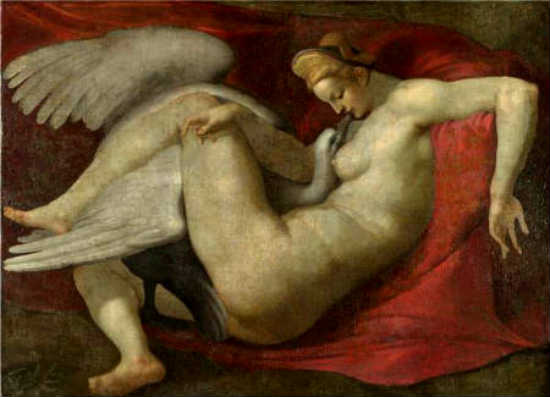
‡ Source of epigraph: The Arabian Nights (Julnar the Sea-born).
Most shared on Macroevolution.net:
Human Origins: Are we hybrids?
On the Origins of New Forms of Life
Mammalian Hybrids
Cat-rabbit Hybrids: Fact or fiction?
Famous Biologists
Dog-cow Hybrids
Prothero: A Rebuttal
Branches of Biology
Dog-fox Hybrids